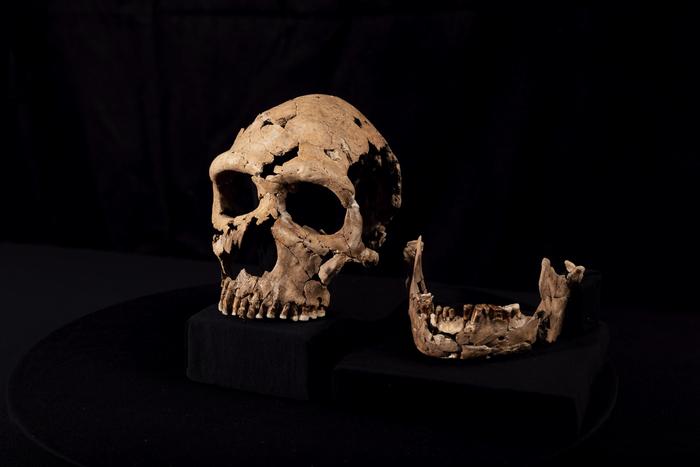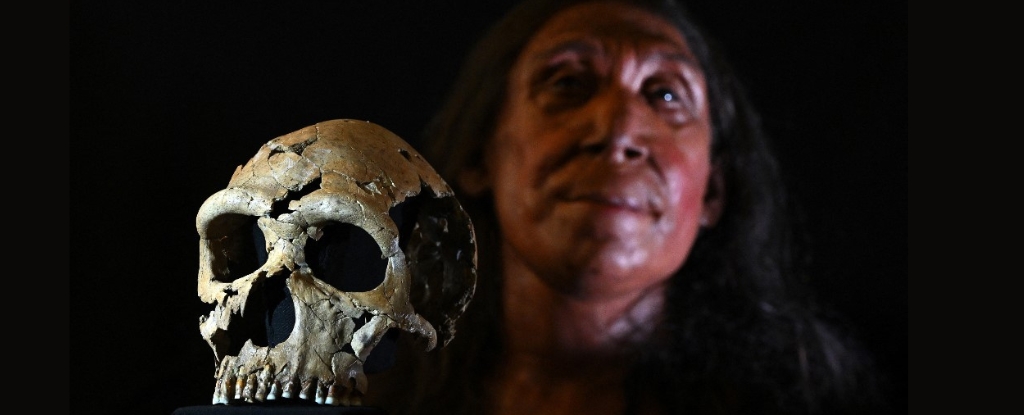Products You May Like
A UK team of archaeologists on Thursday revealed the reconstructed face of a 75,000-year-old Neanderthal woman, as researchers reappraise the perception of the species as brutish and unsophisticated.
Named Shanidar Z after the cave in Iraqi Kurdistan where her skull was found in 2018, the latest discovery has led experts to probe the mystery of the forty-something Neanderthal woman laid to rest in a sleeping position beneath a huge vertical stone marker.
The lower part of her skeleton is believed to have been excavated in 1960 during groundbreaking excavations by American archaeologist Ralph Solecki in which he found the remains of at least 10 Neanderthals.
His discovery of a cluster of bodies with one surrounded by clumps of ancient pollen led him to controversially argue that this was evidence of funerary rituals with the dead placed on a bed of flowers.

Political difficulties meant it took around five decades for a team from Cambridge and Liverpool John Moores universities to be allowed back to the site in the Zagros mountains of northern Iraq.
The last Neanderthals mysteriously died out around 40,000 years ago, just a few thousand years after humans arrived.
Shanidar Z’s skull – thought to be the best preserved Neanderthal find this century – had been flattened to a thickness of two centimeters (0.7 inches), possibly by a rockfall relatively soon after she died.
Professor Graeme Barker from Cambridge’s McDonald Institute for Archaeological Research, who led the excavations at Shanidar cave, told AFP the team had “never expected to get more Neanderthals”.

Flower burial theory
“We wanted to try and date these burials… to use the site to contribute to the big debate about why the Neanderthals died out, and then we started finding these bits,” he said.
Shanidar Z is the fifth body to be identified in the cluster buried over a period of at least several hundred years right behind the rock in the center of the cave.
Archaeologists believe the stone was used as an identifier to allow itinerant Neanderthals to return to the same spot to bury their dead.
Latest research by team member Professor Chris Hunt of John Moores now suggests the pollen that gave rise to Solecki’s contentious “flower burial” theory might in fact have come from bees burrowing into the cave floor.
But Hunt said there was still evidence – such as the remains of a partially paralysed Neanderthal found by Solecki – that the species were more empathetic than previously thought.
“There’s been this huge reappraisal which was actually started by Ralph Solecki in this cave with ‘Shanidar 1’ with his withered arm and his arthritis and his deafness who must have been looked after. That tells us there was compassion,” he said.
The positioning of the bodies in the cluster in the same spot, in the same position and facing in the same direction implied “tradition” and the “passing of knowledge between generations”, he said.

Terrifying
“It looks much more like purposeful behavior that you wouldn’t associate with the text book stories about Neanderthals which is that their lives were nasty, brutish and short,” he added.
Emma Pomeroy, the Cambridge paleo-anthropologist who uncovered Shanidar Z, said finding her skull and upper body had been both “exciting” and “terrifying”.
The skeleton and the surrounding sediment had to be strengthened in situ with a glue-like consolidant before being removed in dozens of small foil-wrapped blocks.
Lead conservator Lucia Lopez-Polin then pieced together the over 200 bits of skull as the first step in the facial reconstruction for the just-released Netflix documentary “Secrets of the Neanderthals”.
Pomeroy said the task had been like a “high stakes 3D jigsaw puzzle” especially as the fragments were very soft “similar in consistency to a biscuit dunked in tea”.

The rebuilt skull was then 3D-printed allowing paleoartists and identical twins Adrie and Alfons Kennis in The Netherlands to complete the reconstruction with layers of fabricated muscle and skin for the documentary, which was produced by the BBC Studios Science Unit.
Pomeroy said Neanderthal skulls looked very different to those of humans “with huge brow ridges and lack of chins”.
But she said the recreated face “suggests those differences were not so stark in life”, highlighting the interbreeding between Neanderthals and humans “to the extent that almost everyone alive today still has Neanderthal DNA.”
